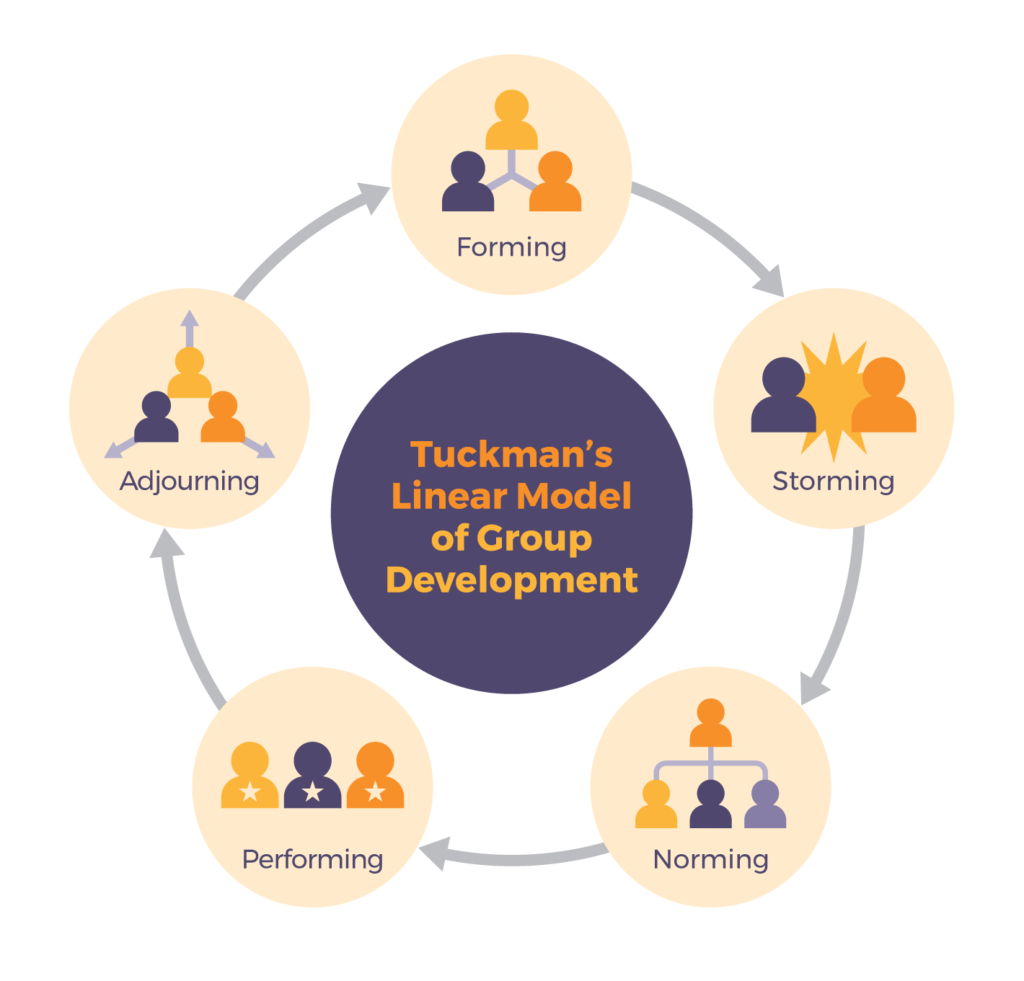4. TEAMWORK AND COMMUNICATION
4.2 Five Models for Understanding Team Dynamics
An important aspect of effective teamwork entails understanding group dynamics in terms of both team situation and individual temperament. The next few pages review a variety models often applied in workplaces that can help a team perform optimally and manage crises effectively.
The Tuckman Team Model
“Tuckman’s Stages of Group Development,” proposed by psychologist Bruce Tuckman in 1965,[1] is one of the most famous theories of team development. It describes four stages that teams may progress through: forming, storming, norming, and performing (a 5th stage was added later: adjourning). According to McCahan et al., the stages move from organizing to producing, and although the stages appear linear, in fact teams may move backwards depending on events that may influence the team and the communications strategies that they use. Some teams can also stall in a stage and never fully realize their potential. Figure 4.2.1 outlines these stages. Please refer to the McCahan et al. text[2] for a more complete discussion.

Figure 4.2.1 The Stages of the Tuckman Model. [3]
Note that at each stage, communication is a critical component of successfully moving to the next stage. The forming stage, when everyone is getting to know each other and are trying to make a good impression, is a good time to create a set of shared expectations, guidelines, or a Team Charter. A team forming activity is also a good idea to help build trust and get to know the various strengths and weaknesses of the team members. This is an orientation stage, on both an interpersonal and professional level, where preliminary boundaries and expectations are established.
The storming stage is the one most often characterized by group conflict and dysfunction. It is often where the preliminary expectations and boundaries are challenged as individuals learn more about each other’s motivations. This coincides with the “brainstorming” stage of the design process, in which each member contributes ideas that could potentially become the focus of the project. It is also the stage where team mates learn about each others’ strengths and weaknesses, and try to determine what their roles will be in the project. Learning to harness the constructive potential of conflict and compromise in this stage is important to progressing to the next stage.
During the norming stage, if conflicts have been resolved and team mates have proved flexible, all is going well, each team member knows their role and works on their part of the project. Sometimes, people work independently in this stage, but check in with team mates frequently to make sure work flow is efficient and effective. Group cohesion ensures that everyone is responsible to the task and to each other. Problems might arise at this stage if teammates do not fully understand their role, the team expectations, or the overall goal; revisiting the forming or storming stage may be required.
Few first-time teams reach the performing stage, as this happens when teams have worked together well on several projects, have established a synergy, and have developed systems that that make projects go smoothly and efficiently. Less time is needed to form, storm and learn to norm; performing teams can move quickly and interdependently to tackling the task at hand. Adjourning and going their separate ways can often be somewhat emotional for these teams. Figure 4.2.2[4] depicts the trajectory of each team member during each stage.
![DIogo Nicoleti [CC BY-SA 4.0 (https://creativecommons.org/licenses/by-sa/4.0)], from Wikimedia Commons Forming: 4 arrows pointing to the centre. Storming, 4 arrows going in various random directions. Norming: 4 arrows going in almost the same direction. Performing: 4 arrows perfectly aligned. Adjourning: 4 arrows pointing outward from the centre in the 4 cardinal directions.](https://pressbooks.bccampus.ca/knowinghome/wp-content/uploads/sites/1298/2021/02/Screen-Shot-2018-11-24-at-1.40.42-PM-1024x247.png)
Review the components of the Tuckman model and then use the H5P interaction to test your knowledge. Drag the correct description to the appropriate component.
Next we will look at the DISC Model.
- B. Tuckman, "Developmental sequence in small groups," Psychological Bulletin, vol. 63, no. 6, pp. 384-399. Available: http://dx.doi.org/10.1037/h0022100 : ↵
- S. McCahan, P. Anderson, M. Kortschot, P. E. Weiss, and K. A. Woodhouse, “Introduction to teamwork,” in Designing Engineers: An Introductory Text, Hoboken, NJ: Wiley, 2015, pp. 219-246. ↵
- eCampus Ontario. “Tuckman’s Linear Model of group development”, in Communication for Business Professionals - Canadian Edition [Online]. eCampus Ontario, 2018. Available: https://ecampusontario.pressbooks.pub/commbusprofcdn/. CC-BY-SA. ↵
- Dlogo Nicoleti. “Modelo de Tuckman.png”, Wikimedia Commons, https://commons.wikimedia.org/wiki/File:Modelo_de_Tuckman.png . CC BY-SA 4.0 . ↵

